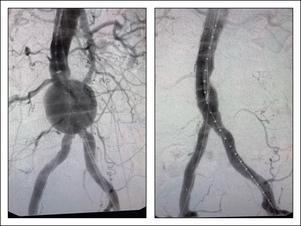An aneurysm is an abnormal dilatation of an artery above a certain size and these can effect any artery in the body. As for the aorta, the largest blood vessel in the body, the most common place this occurs is in the abdomen. Most often times, aneurysms are found incidentally by either CT scan or ultrasound done for another condition. However, screening in at risk populations (>60 y/o, smokers) is now very common so abdominal aortic aneurysms (AAA) rarely go undetected. They are considered for repair once they are larger than 5 cm in females and 5.5 cm in males. In practice, once you’re above 5 cm its usually just a matter of time before it will be addressed electively. Elective repair has a much lower complication rate and better outcome than emergent repairs. The aorta can be fixed with a minimally invasive approach using a covered stent that is introduced into the artery via the leg arteries (if it has the appropriate anatomy) or by open repair. Most people these days can have a minimally invasive repair.
If less than 5 cm they can be followed at regular intervals by US. CT scan is done once the AAA meets size criteria for repair.

